
The shrimp fishery is a major global industry, with more than 3.4 million tons caught per year, chiefly in Asia. Rates of bycatch are unusually high for shrimp fishing, with the capture of sea turtles being especially contentious.
The glassy sprat is a type of sprat fish. The fish, when alive, is translucent, so it gets the second word in its scientific name from the Latin word translucidus, meaning transparent, diaphanous. In animal classification the glassy sprat belongs to Osteichthyes, Clupeiformes, Clupeidae, Hyperlophus. The glassy sprat is native to Australia and mainly found in Australia. It is marked as NE because it has not yet been evaluated by the World Animal Protection. It is mainly used as an economical aquatic product. In ecosystems, they are at the bottom end of the food chain, feeding mainly on plankton, which are less aggressive and very vulnerable to other fish. Glassy sprat are tiny in size and translucent with a silvery streak that extends from its tail to just behind its head. As early as a hundred years ago, Australians harvested the glassy sprat in large quantities and it featured on the table as food for a long time. Due to its poor appearance, it is not a very good ornamental fish.
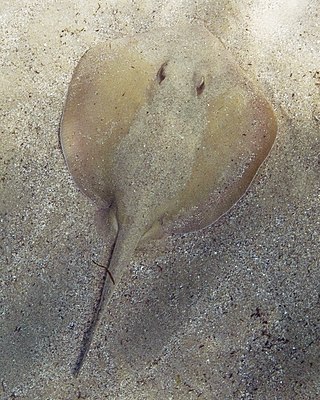
The common stingaree is a species of stingray in the family Urolophidae. The most abundant ray in inshore waters off eastern Australia, it generally inhabits estuaries, sandy flats, and rocky reefs from the shore to a depth of 60 m (200 ft). This plain brownish to grayish species has a rounded pectoral fin disc with a broadly triangular snout. Its nostrils have enlarged lobes on their outer margins and a skirt-shaped curtain of skin with a fringed posterior margin between them. Its tail bears a small dorsal fin before the stinging spine, and terminates in a leaf-shaped caudal fin. This ray can grow to 52 cm (20 in) long.

The Kapala stingaree is a species of stingray in the family Urolophidae, endemic to inshore waters off southeastern Queensland and New South Wales. It is commonly found on and around rocky reefs at a depth of 10–130 m (33–427 ft). Reaching 51 cm (20 in) in length, the Kapala stingaree has a rounded, diamond-shaped pectoral fin disc and a slender tail, which ends in a leaf-shaped caudal fin and bears lateral skin folds and a small dorsal fin in front of the stinging spine. It has a distinctive bell-shaped curtain of skin between its nostrils. This species is greenish above, with a highly variable pattern of dark markings usually found outside and between the eyes, and over the back and tail.
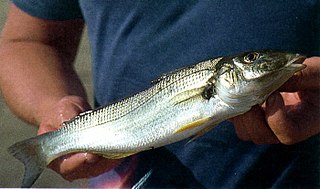
The sand whiting, also known as the summer whiting, yellowfin whiting or blue-nose whiting, is a common species of coastal marine fish of the family Sillaginidae, the smelt-whitings. It is a slender, slightly compressed fish that is very similar to other species of Sillago, with detailed spine, ray and lateral line scale counts needed to distinguish the species between its nearest relative Sillago analis. The sand whiting is distributed along the east coast of Australia from Cape York south to Tasmania, as well as Lord Howe Island and New Caledonia in the Pacific Ocean.
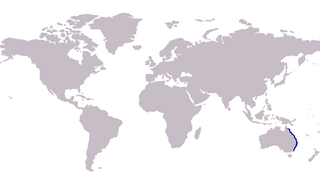
The trumpeter whiting, also known as the winter whiting or diver whiting, is a common species of coastal marine fish of the smelt-whiting family, Sillaginidae. The trumpeter whiting is endemic to Australia, inhabiting the eastern seaboard from southern New South Wales to northern Queensland. The species is found in bays, estuaries, coastal lakes and mangrove creeks on silty and muddy substrates in waters ranging from 0 to 30 m deep, occasionally inhabiting sandy and seagrass beds.

The Malabar trevally, also known as the Malabar jack, Malabar kingfish or nakedshield kingfish, is a species of large inshore marine fish of the jack family, Carangidae. It is distributed throughout the Indian and west Pacific Oceans from South Africa in the west to Japan and Australia in the east, inhabiting reefs and sandy bays on the continental shelf. The Malabar trevally is similar to many of the other species in the genus Carangoides, with the number of gill rakers and the grey-brown colour of the tongue being the diagnostic features. The Malabar trevally is a predator, taking a variety of small fish, cephalopods and crustaceans. The species is of minor economic importance throughout its range, caught by a variety of net and handline methods.

Argyrosomus japonicus is a silvery to bronze-green colored fish, a member of the family Sciaenidae, which may grow up to 2 m in length. It is known as Japanese meagre (FAO), mulloway or jewfish on the east coast of Australia, butterfish in South Australia, kingfish or river kingfish in Western Australia, and dusky/squaretail kob, dusky salmon, salmon, Kob, or kabeljou in South Africa, Ô-nibe in Japan. The name jewfish refers to its large otoliths, which are prized as "jewels" by some fishers.

The stout whiting, also known as the yellow-cheek whiting or school whiting, is a species of benthic marine fish in the smelt-whiting family Sillaginidae. Like other sillaginids, it is an elongate, slightly compressed fish, growing to a maximum known length of 30 cm. The stout whiting is endemic to Australia, with the species divided into western and eastern populations, with the western population ranging from Shark Bay to Fremantle and the eastern population from Bustard Head, Queensland to northern New South Wales. The species inhabits deep, sandy continental shelf regions to a depth of at least 70 m.
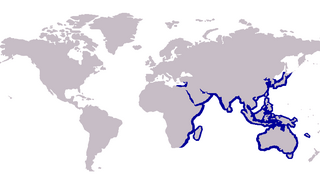
Smelt-whiting is the common name for various species of the family Sillaginidae. The Sillaginidae are distributed throughout the Indo-Pacific region, ranging from the west coast of Africa to Japan and Taiwan in the east, as well occupying as a number of small islands including New Caledonia in the Pacific Ocean. Well known members of this family include King George whiting, Japanese whiting, northern whiting, sand whiting and school whiting.

The eastern shovelnose ray is a species of guitarfish in the family Rhinobatidae of order Rhinopristiformes. The species is endemic to the east coast of Australia and inhabits subtropical and temperate waters from southern Queensland to southern New South Wales.

Trachysalambria curvirostris is a species of prawn that lives in shallow waters of the Indo-West Pacific. It is one of the most important species targeted by prawn fishery, with annual harvests of more than 300,000 t, mostly landed in China.

A shrimp is a crustacean with an elongated body and a primarily swimming mode of locomotion – typically belonging to the Caridea or Dendrobranchiata of the decapod order, although some crustaceans outside of this order are also referred to as "shrimp".

The fringefin trevally, also called fringe-finned trevally, round-finned trevally or reef herring, is a species of inshore marine fish classified in the jack and horse mackerel family Carangidae. A relatively small fish, the fringefin trevally is known to reach 40 cm (16 in), but is mostly encountered at lengths less than 25 cm (9.8 in). The fringefin trevally has an ovate body, with distinctive orange-yellow fins and a black opercular spot. The dental patterns of the species distinguish it from the closely related scads of the genus Alepes. Males have characteristic elongated dorsal and anal fins which produce a series of trailing filaments. The fringefin trevally is restricted to the waters of the Indo-Pacific, ranging from northern Australia to Papua New Guinea and eastern Indonesia. An inshore species, it is found in coastal and estuarine environments and exhibits daily and seasonal movements. The fringefin trevally is predatory, taking crustaceans as prey. The species is often taken as bycatch in prawn trawls and occasionally taken by anglers.

The longrakered trevally, also known as the cale cale trevally and heavyjawed kingfish, is a species of marine fish in the jack and horse mackerel family Carangidae. The longrakered trevally is distributed throughout the tropical and subtropical waters of the Indian and west Pacific Oceans, from Mozambique and Madagascar in the west, to Japan and northern Australia in the east. A large species growing to a recorded length of 1 m, the longrakered trevally is distinguished by is protruding lower jaw, elongated gill rakers and lack of villiform teeth on its tongue. It is an inshore species, restricted to coastal and estuarine regions, where it preys on fishes and crustaceans. Little is known of the species reproductive cycle or growth. The longrakered trevally is of minor importance to fisheries and is often taken as bycatch in finfish and prawn trawls, as well as by recreational fishermen.

Metapenaeus is a genus of prawns, containing the following species:

Ambassis macleayi, commonly known as Macleay's glassfish, Macleay's glass perchlet, Macleay's perchlet, reticulated glassfish, reticulated perchlet, or network perchlet, is a species of freshwater fish in the family Ambassidae. It is native to northern Australia and the trans-Fly River region of New Guinea. It is a fish with a vertically flat, narrow body and a standard length generally between 35 and 45 mm, with large specimens reaching 77 mm (3.0 in) long. It generally eats water fleas and other small invertebrates. This fish is considered to be a least-concern species according to the International Union for Conservation of Nature (IUCN), although it could suffer from habitat degradation due to feral pigs and invasive water plants such as the water hyacinth. The fish is suitable for aquarium use in tanks containing other non-aggressive species.

Pomadasys maculatus, commonly known as the saddle grunt, blotched grunt or blotched javelin, is a species of marine ray-finned fish, a grunt belonging to the family Haemulidae. It is native to the Indo-West Pacific region.
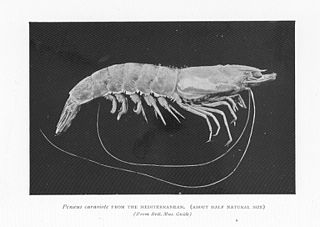
Melicertus kerathurus, the striped prawn or caramote prawn is a species of tiger prawn from the family Penaeidae which occurs in the eastern Atlantic and Mediterranean Sea which is an important species in commercial fisheries. It is the type species for the genus Melicertus.

The eastern king prawn is an edible dendrobranch prawn endemic to eastern Australia. Its scientific name is Melicertus plebejus or Penaeus plebejus. It is caught by commercial and recreational fishers for human food.


















